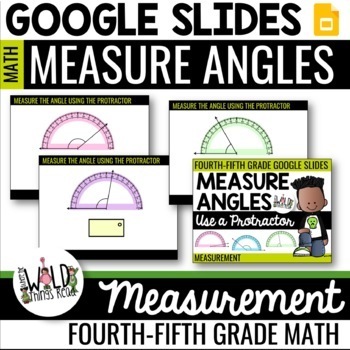Measure Angles with a Protractor Google Slides
Where the Wild Things Read
94 Followers
Grade Levels
3rd - 7th
Subjects
Resource Type
Standards
CCSS4.MD.C.6
CCSSMP5
Formats Included
- Google Slides™
Where the Wild Things Read
94 Followers

Made for Google Drive™
This resource can be used by students on Google Drive or Google Classroom. To access this resource, you’ll need to allow TPT to add it to your Google Drive. See our FAQ and Privacy Policy for more information.
Also included in
- This product is for digital use on the Boom Learning website and for use with Google Slides. There are three products included:1. Identify Angles2. Estimate Angle Measurement3. Measure Angles with a Protractor4. Additive Angles**Bonus Included: Angles Posters & Additive Angles Printable/ Easel APrice $36.00Original Price $54.00Save $18.00
Description
Use these Google Slides to measure the angles on each page with the protractors.
*Take note that this product is for digital use in Google Slides. The product is also available for purchase as Boom Cards here.
Happy Teaching & Learning!
Total Pages
Answer Key
N/A
Teaching Duration
N/A
Last updated Feb 18th, 2021
Report this resource to TPT
Reported resources will be reviewed by our team. Report this resource to let us know if this resource violates TPT’s content guidelines.
Standards
to see state-specific standards (only available in the US).
CCSS4.MD.C.6
Measure angles in whole-number degrees using a protractor. Sketch angles of specified measure.
CCSSMP5
Use appropriate tools strategically. Mathematically proficient students consider the available tools when solving a mathematical problem. These tools might include pencil and paper, concrete models, a ruler, a protractor, a calculator, a spreadsheet, a computer algebra system, a statistical package, or dynamic geometry software. Proficient students are sufficiently familiar with tools appropriate for their grade or course to make sound decisions about when each of these tools might be helpful, recognizing both the insight to be gained and their limitations. For example, mathematically proficient high school students analyze graphs of functions and solutions generated using a graphing calculator. They detect possible errors by strategically using estimation and other mathematical knowledge. When making mathematical models, they know that technology can enable them to visualize the results of varying assumptions, explore consequences, and compare predictions with data. Mathematically proficient students at various grade levels are able to identify relevant external mathematical resources, such as digital content located on a website, and use them to pose or solve problems. They are able to use technological tools to explore and deepen their understanding of concepts.






